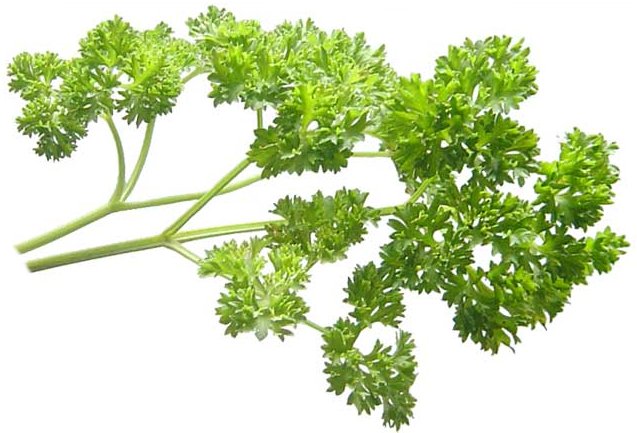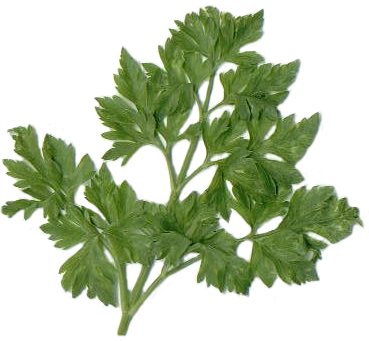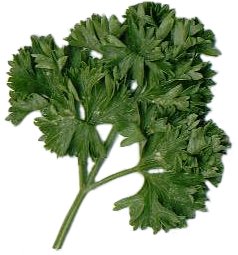

Parsley

Petroselinum. (From petros, a rock, and Selinum.) PARSLEY. Umbelliferae. Three species of biennials, from thick rootstock. Leaves 1-3-pinnate. Umbels compound; involucre and involucels present; calyx teeth minute; flowers white, green-yellow tinged red; petals emarginate, apex inflexed. Fruit ovoid, slightly compressed laterally; mericarps with filiform ridges; vittae solitary. Europe. CultivationA biennial herb, usually cultivated as an annual for its leaves, which are used for flavouring and garnishing. A dual-purpose form of the species, know as Hamburg or turnip-rooted parsley, is also cultivated for its parsnip-shaped roots which provide a good winter vegetable. The leaves of Hamburg parsley are hardier than those of the common parsley. The species is a native of southern Europe and has become naturalised in many temperate countries. It is widely cultivated throughout the world including tropical regions. Parsley is thus tolerant to a fairly wide range of environmental conditions. The natural season of availability is from summer through to early winter but can be readily extended by protecting plants with, for example, cloches or a layer of straw. Both the stems and leaves can be used as a flavouring and the curly-leaved forms provide an attractive garnish. The broad-leaved forms are said to have a better flavour. Parsley is difficult to dry satisfactorily but may be readily frozen. 
A fertile, moisture-retentive soil in either a sunny or partially shaded situation is preferable. The crop grows poorly on light acid soils and plants cannot tolerate poorly drained conditions. Parsley is propagated from seed which is usually sown direct in drills 2cm deep to achieve a final spacing of about 10cm between plants. Hamburg parsley should be spaced at twice this distance to permit full development of the roots. Germination is often slow and may take as long as four to six weeks. It is important to keep the soil moist during this period. Alternatively, plants may be raised under protection in modular trays for transplanting when soil conditions are favourable. Plants should be kept well watered and free of weeds throughout the growing season. For continuity an early sowing should be made in the spring to provide the main summer supply. A summer sowing will ensure fresh leaves for the autumn and early winter period. The latter can be extended by providing protection to the plants in situ or potting up a few for transfer to a cold glasshouse where they will provide a supply through the winter until the following spring. Harvest by cutting fresh leaves as required. Cutting plants back to ground level from time to time will ensure regrowth of fresh leaves. The roots of the Hamburg form may be lifted during the winter and used in a similar way to parsnips. The main pest and disease problems are carrot fly and aphids, which can transmit the carrot motley dwarf virus. Petroselinum crispumPARSLEY. Glabrous biennial to 80cm; stem striate, solid. Leaves triangular in outline, 3-pinnate, segments ovate, base cuneate, to 3cm, petiole sheathing at base, margins toothed, 3-flowered (often crispate in cultivars); upper stem leaves with entire sheathing petiole. Umbels with 8-20 rays, to 3cm, flat-topped, terminal umbel with bisexual flowers, lateral umbel with male and bisexual flowers; involucral bracts 1-3, entire to 3-flowered; involucel of 5-8 bracteoles, small; flowers yellow. Fruit to 3mm; mericarps with low ridges, commisure narrow. Summer. Europe. Over 20 cultivars; very dwarf and compact to tall and upright, some exceptionally hardy; leaves lightly curled to flat, deeply to finely cut, very dark green to bright emerald. ‘Afro’ (tall, upright; leaves tightly curled, dark green), ‘Clivi’ (dwarf, neat; base leaves remain green), ‘New Dark Green’ (very dwarf, compact, hardy; leaves bright emerald green), ‘Paramount’ (hardy, vigorous growth; leaves very dark green, dense, closely curled), ‘Italian Plain Leaf’ (leaves flat, plain, deeply cut, dark green), ‘Darki’ (very tolerant of cold; leaves very dark green, tightly curled), ‘Crispum’ (leaves plain, strong flavour), ‘Champion Moss Curled’ (leaves curled, finely cut, deep green). variety neopolitanum ITALIAN PARSLEY. Leaves not curled. variety tuberosum. TURNIP-ROOTED PARSLEY; HAMBURG PARSLEY. Root thick, fleshy, white, edible with nutty flavour.
|
Home
Grow Nuts
Grow Fruit
Grow Vegetables
Cyberian Index
If you like this website and want one of your own contact
Cyberian All information correct at
time of publication and open to updates as necessary. No part of this website,
or its vectors, may be produced in any shape or form, using any type or design
of medium, system, equipment or otherwise without the prior written consensual
notice of the Cyberian. Any breach of these requirements will result in the
appropriate action. If in doubt, e-mail contact is recommended.
Some components of this website were obtained as open-source software and are
used in the same non-profit manner on this website.